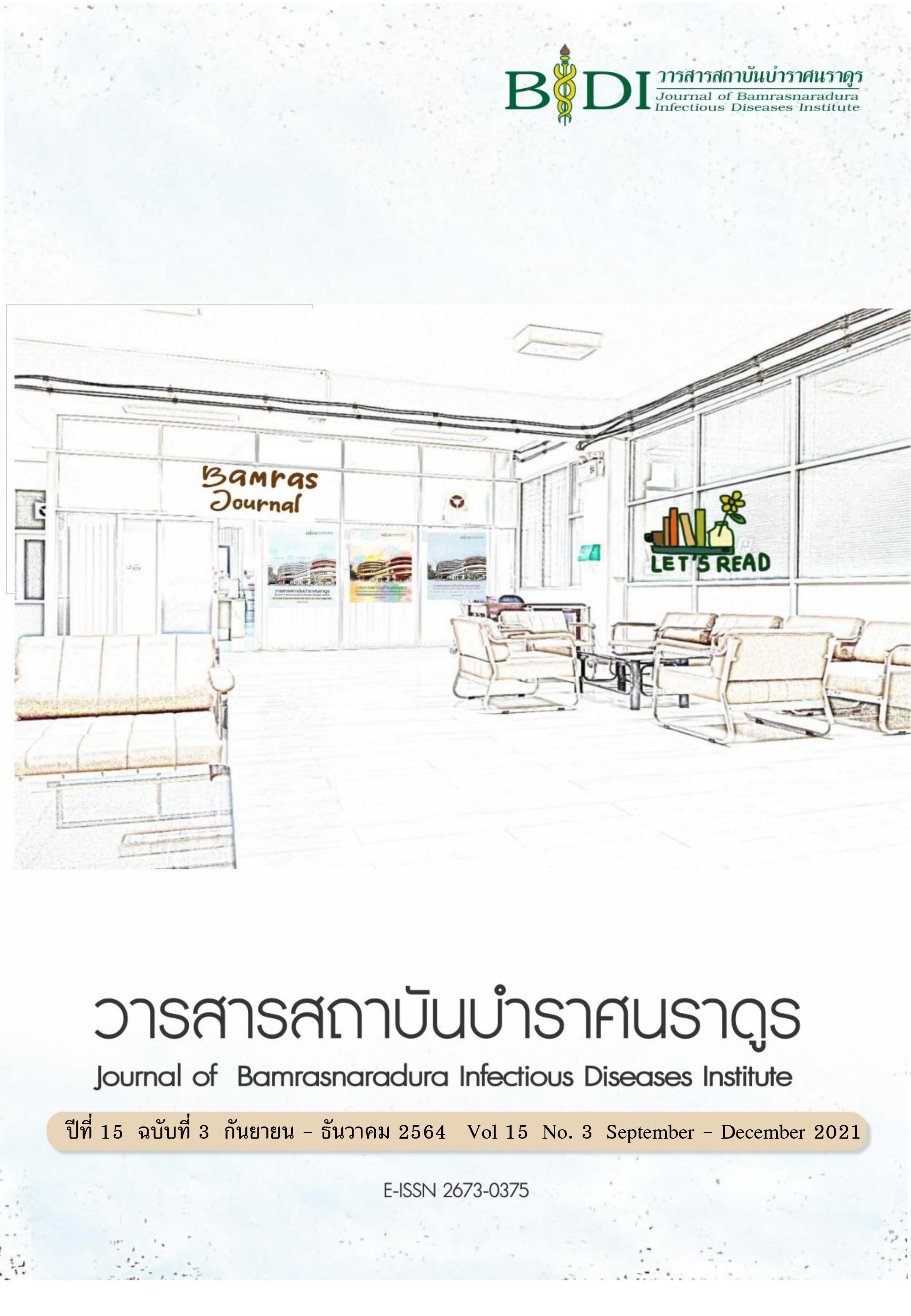การศึกษาการติดเชื้อในกระแสเลือดและความไวต่อยาต้านจุลชีพ ของแบคทีเรียซึ่งแยกจากผู้ป่วยในโรงพยาบาลปทุมธานี ปี พ.ศ. 2556-2561
Main Article Content
บทคัดย่อ
การติดเชื้อแบคทีเรียในกระแสเลือด (Bacteremia) เป็นสาเหตุที่สำคัญซึ่งทำให้ผู้ป่วยในโรงพยาบาลเสียชีวิต จากการศึกษาตัวอย่างเลือดของผู้ป่วยโรงพยาบาลปทุมธานีที่ส่งมาเพาะเชื้อและทดสอบความไวต่อยาระหว่างปี พ.ศ. 2556-2561 จำนวนทั้งหมด 78,110 ตัวอย่าง พบเชื้อแบคทีเรียในกระแสเลือดจำนวน 6,450 ไอโซเลท คิดเป็นร้อยละ 8.3 โดยเป็นเชื้อแบคทีเรียชนิดแกรมบวกร้อยละ 57.1 และแบคทีเรียชนิดแกรมลบร้อยละ 42.9 พบมีความแตกต่างอย่างมีนัยสำคัญทางสถิติเมื่อทดสอบด้วย Chi-square เชื้อแบคทีเรียที่ตรวจพบมากที่สุด 5 อันดับแรก คือ Methicillin-resistant Staphylococcus epidermidis (MRSE), Coagulase-negative staphylococcus, Escherichia coli, Staphylococcus aureus และ Viridans group streptococci โดยพบร้อยละ 21.2, 16.4, 13.9, 9.5 และ 7.7 ตามลำดับ เชื้อแบคทีเรียชนิดแกรมบวก MRSE พบมีความไวสูงต่อยา Linezolid ร้อยละ 96.0 Vancomycin ร้อยละ 92.5 และมีความไวต่ำต่อยา Oxacillin เพียงร้อยละ 1.5 และเชื้อแบคทีเรียชนิดแกรมลบ Escherichia coli ที่พบมีความไวสูงต่อยา Amikacin ร้อยละ 97.9 ส่วนยาในกลุ่มของ Carbapenem มีความไวสูงต่อ Meropenem, Ertrapenem และ Imipenem ร้อยละ 99.7, 98.9 และ 93.4 ตามลำดับ แต่มีความไวต่ำต่อยา Ampicillin เพียงร้อยละ 20.3 การทราบอัตราการติดเชื้อแบคทีเรียในกระแสเลือด และความไวต่อยาต้านจุลชีพจึงมีประโยชน์ต่อแพทย์เพื่อใช้เป็นแนวทางในการรักษาและการเลือกใช้ยาต่อผู้ป่วยได้อย่างเหมาะสม และสามารถนำข้อมูลไปเป็นแนวทางในการวางแผนป้องกันและควบคุมการติดเชื้อแบคทีเรียในกระแสเลือดร่วมกับหน่วยงานป้องกันและควบคุมการติดเชื้อของโรงพยาบาล
Article Details
เอกสารอ้างอิง
Leelarasamee A. Lepsis. In: Suwannakul P, Likitnukul S, Tantawichien T, editors. An update on infectious diseases. Bangkok: Savicharnkarnpim; 2005. p. 68-9. (in Thai)
Rungsipanurat V, Janwitthayanuchit I, Pingmuang P, Ngamurulert S, Chuwongwattana S. Medical diagnosis of bacterial infection. 3rd ed. Bangkok: Chulalongkorn University press; 2010. p. 75-97, 271-96. (in Thai)
Clinical and Laboratory Standards Institute. Methods for dilution antimicrobial susceptibility tests for bacteria that grow aerobically. M07-A10. Pennsylvania: Clinical and Laboratory Standards Institute, 2015.
Clinical and Laboratory Standard Institute (CLSI). M 100 Performance Standard for Antimicrobial susceptibility Testing. 27th ed. Pennsylvania: CLSI; 2017.
Bezuidenhouta J. Kirby-Bauer (antibiotic sensitivity) [Internet]. 2019 [cited 2020 May 11]. Available from: https://bio.libretexts.org/Bookshelves/Ancillary_Materials/44Laboratory_Experiments/Microbiology_Labs/Microbiology_Labs_I/09%3A_Kirby-Bauer_ (Antibiotic_Sensitivity)
Chantrakooptungool S, Kanjanahareutai S, Rahule S, Thongkoom P. Incidence and antimicrobial susceptibility patterns of bacteria causing bloodstream infection in Rajavithi Hospital. J Med Tech Assoc Thailand 2011 December; 39(3): 3970-86. (in Thai)
Uyanik MH, Yazgi H, Ozden K, Erdil Z, Ayyildiz A. Comparison of coagulase-negative Staphylococci isolated from blood cultures as a true bacteremia agent and contaminant in terms of slime production and methicillin resistance. Eurasian J Med 2014 Jun; 46: 115-9. doi: 10.5152/eajm.2014.26 PMID: 25610309
Poorabbas B, Mardaneh J, Rezaei Z, Kalani M, Pouladfar G, Alami MH, et al. Nosocomial Infections:multicenter surveillance of antimicrobial resistance profile of Staphylococcus aureus and Gram negative rods isolated from blood and other sterile body fluids in Iran. Iranian J of microbiology 2015 Jun; 7(3): 127-35. PMID: 26668699
Sapkota J, Sharma M, Jha B, Bhatt CP. Prevalence of Staphylococcus aureus isolated from clinical samples in a tertiary care hospital: a descriptive cross-sectional study. J Nepal Med Assoc 2019 Nov-Dec; 57(220): 398-402. PMID: 32335648
Deplano A, Vandendriessche S, Nonhoff C, Dode´mont M, Roisin S and Denis O. National surveillance of Staphylococcus epidermidis recovered from bloodstream infections in Belgian hospitals. J Antimicrob Chemother 2016 Apr; 71: 1815-9. doi:10.1093/jac/dkw086
Palomar NM, Carulla MB, Lauro SG, Céspedes MC, Andreu A, Frick MA, Linde MA, Palacin PS. Escherichia coli early-onset sepsis: trends over two decades. Eur J Pediatr 2017; 176: 1227-34. doi: 10.1007/s00431-017-2975-z
Cuny C, Layer F, Werner G, Harmsen D, Daniels-Haardt I, Jurke A, et al. State-wide surveillance of antibiotic resistance patterns and spa types of methicillin-resistant Staphylococcus aureus from blood cultures in North Rhine-Westphalia, 2011–2013. Clin Microbiol Infect 2015 Feb 20; 21: 750-7. doi: 10.1016/j.cmi.2015.02.013 PMID: 25704447
Mustafa M, Ahmed SL. Bacteriological profile and antibiotic susceptibility patterns in neonatal septicemia in view of emerging drug resistance, Journal of Medical and Allied Science 2014; 4 (1): 2-8. Corpus ID: 212588338
Wunderink RG, Niederman MS, Kollef MH, Shorr AF, Kunkel MJ, Baruch A, et al. Linezolid in methicillin-resistant Staphylococcus aureus nosocomial pneumonia: a randomized, controlled study. Clinical Infectious Diseases 2012 Jan 12; 54(5): 621-9. doi: 10.1093/cid/cir895 PMID: 22247123
May L, Klein EY, Rothman RE, Laxminarayanc R. Trends in antibiotic resistance in coagulase-negative staphylococci in the United States, 1999 to 2012. Antimicrob Agents Chemother 2013 Dec 16; 58 (3): 1404-9. doi: 10.1128/AAC.01908-13 PMID: 24342646
Ministry of Public Health. Thailand strategic plan for antimicrobial resistance management B.E. 2560–2564 [Internet]. 2016 [cited 2020 September 23]. Available from: http://narst.dmsc.moph.go.th/documentation/AMR%20strategy%202560-2564.pdf (in Thai)


